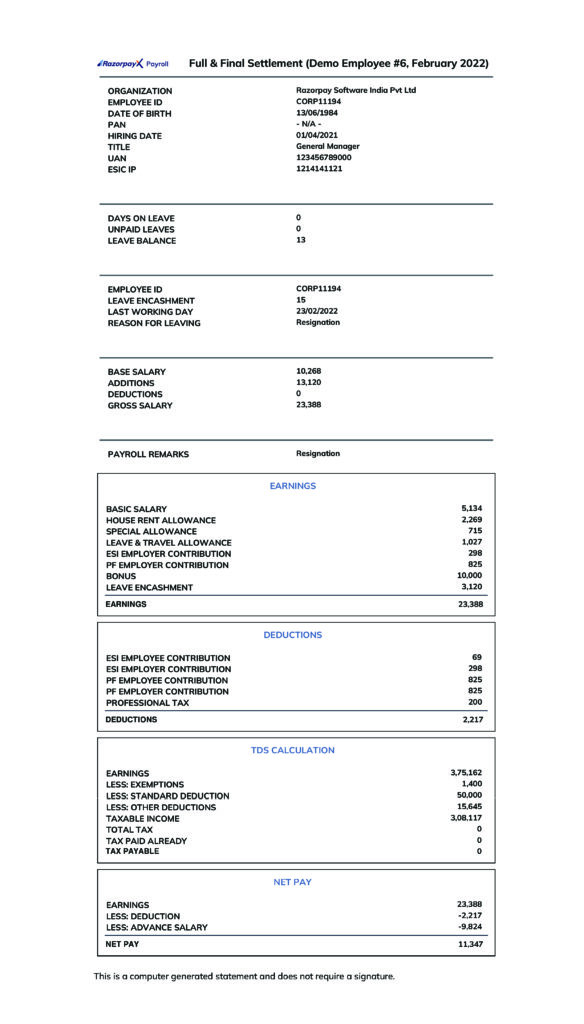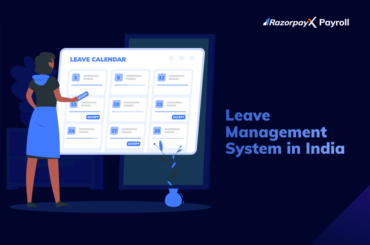Full and final settlement is the process of calculating all the dues payable to an employee who resigns, retires, or is removed by the management. The settlement process is not just limited to the salary drawn by the employee but also deductions.
This article covers all you need to know about the full and final settlement process and the calculations involved.
Table of Contents
What is full and final settlement?
Whether an employee resigns from the job or is let go by the management, they are paid all the dues for their service till the last working day as FnF or full and final settlement. This includes any additional earnings or deductions as well.
What are the rules for FnF settlement?
In India, Full and Final Settlements are subject to legal regulations and guidelines. The Payment of Wages Act is a significant piece of legislation that governs this process. The Act outlines the timing and modes of wage payments, ensuring that employees are fairly compensated.
Under the Act, employers are required to disburse Full and Final Settlements within a specific timeframe, typically within seven to ten days from the last working day. This legal requirement aims to safeguard employees’ rights and provide them with timely access to their dues.
Policy for full and final settlement
Accurate and well-maintained documentation is paramount during Full and Final Settlements. Here’s a list of essential documents that both employers and employees should be familiar with:
- Resignation Letter: The departing employee’s formal resignation letter serves as the starting point of the process.
- Offer Letter and Appointment Letter: These documents help in verifying terms of employment, job role, and salary details.
- Attendance and Leave Records: Accurate attendance and leave records help calculate pending leave encashment.
- Salary Slips: Salary slips provide a detailed breakdown of salary components, aiding in accurate calculations.
- Tax-related Documents: Documents like Form 16 are vital for tax-related calculations.
- Gratuity and Provident Fund Details: These records ensure accurate gratuity and PF calculations.
- Expense Reimbursement Records: Reimbursement claims and receipts help finalize pending reimbursements.
Major components & activities included in the full and final settlement
The full and final settlement consists of clearances from various departments like IT, finance, HR, and admin. Also, it is important to understand which components to include while calculating the final dues payable to the employee. Let’s look at each of the activities in detail:
Financial Clearance
This involves any outstanding reimbursements, expenses on company cards. Following are the various components to calculate the final dues payable to the employee:
1. Outstanding/Unpaid Salary
As per the Payment of Wages Act, 1936, the salary due for the previous month should be paid up to the 7th or 10th of the following month. But, when the employee resigns from a job, the salary due up to the date of resignation needs to be calculated.
Unpaid salary also includes the annual benefits payable to employees like LTA (leave travel allowance) or other arrears. Since these amounts are usually paid once in the year, the liability should be calculated up to the employee’s last working day.
The calculation of this will depend on your company’s policy around benefits.
Recommended read: Gross Salary Meaning, Components & Calculation
2. Unavailed Leaves and Bonus
As per the provisions of the Factories Act, 1948, the amount of unavailed leaves and bonuses need to be cleared by the 7th or 10th of the following month after the resignation.
The leaves available to the employees are different from company to company depending on a company’s policy. These leaves are usually called privilege leaves available for employees against continued service.
Here again, the leave encashment policy varies from company to company and hence the calculation of this component will depend on it.
Read more in our blog post ‘Leave Encashment Calculation.’
Similarly, bonuses can be awarded by the employer on special occasions or for exemplary performance by the employees. Any amount of the bonus awarded to the employee must also be paid.
3. Employee Provident Fund (EPF or PF)/Pension
A portion is deducted from the employee’s salary every month, and the employer also contributes the same amount. This pool of funds is deposited by the employer as Provident Fund and Pension Fund for the employees and helps build a corpus.
Provident Fund is payable to all employees in confirmed service, while Pension is payable on completion of 10 years of service on FnF settlement.
If the employee is resigning to join a new job, the PF/Pension can be transferred to the new employer or paid to the employee. On retirement, the fund balance is payable to the employees.
Read more about ‘Employee Provident Fund’ in this blog post
4. Gratuity
As per the Payments of Gratuity Act, gratuity is payable to an employee who has served the company for 4 years and 10 months or more. Any employee resigning from the job or being terminated after completion of this period is entitled to receive gratuity payment within 30 days. If there is any delay in payment of Gratuity during FnF settlement beyond 30 days, interest is payable to the employee.
Read more about ‘Gratuity & its calculation’ in this blog post
5. Deductions from Full and Final Settlement
Any tax liability arising on the FnF amount is chargeable from the amount payable. TDS is deductible from the components that are taxable under the Income Tax Act, 1961. Although, the amount paid for gratuity and unpaid leaves is exempt from TDS under the Income Tax Act.
6. Leave Encashment
Leave encashment in Full and Final Settlement (FnF) refers to the process of converting unused earned leaves into a monetary payout when an employee is leaving the organization.
The leave encashment amount is calculated based on the employee’s daily wage or salary and the number of earned leaves they have accrued but not utilized. The formula for calculating leave encashment can vary based on company policies and labour laws in the specific region or country.
IT Clearance
This involves returning company assets such as laptop, monitor, keyboard or mouse – whatever asset was provided to the employee on the last working day. In case of any damage, the same can be recovered from the employee FnF.
Employee account is updated with resigned/removed (whatever applicable) and email ID is deleted from the IT infrastructure.
HR Clearance
There are various HR policies that vary from company to company related to joining bonus, L&D, and notice period. Based on an employee’s tenure or company policy the joining bonus or a company’s latest bonus might be recovered in the FnF settlement.
Also, if the notice period falls short, the employee may/may not have to pay the relevant amount in the FnF settlement.
Admin Clearance
This involves getting the employee ID card or other related assets that are usually needed for entry/access in the company.
When does the full and final settlement take place?
It is essential to note that an employee, whether resigning or being terminated, has the right to get all the dues settled within a reasonable timeframe. It is a common practice to finalise the process within 30-45 days from the employee’s last working day.
If the employer fails to fulfil the FnF settlement requirements, the employee can contest it legally, and the employer will be liable to pay interest on all the dues as a penalty.
Full and final settlement payslip format
The FnF settlement letter is issued with reference to the resignation letter submitted by the employee. There is no set format for the FnF letter and sometimes companies just generate a payslip in place of the letter. The following details should form part of the payslip.
- Name of the employee
- Employee ID
- Date of Resignation
- Reason for leaving
- Details of FnF settlement amount
Download FnF Payslip Format in Word for Free
Download FnF Payslip Format in PDF for Free
A few pointers for employers to keep in mind:
While computing the value of FnF settlement amount, the employers should keep the following points in mind:
- Clear records of all the correspondences with the employee should be maintained.
- The settlement value must be calculated as per the governing laws.
- FnF settlement should be made within a reasonable time.
- TDS should be deducted from the incomes that attract taxation.
- Detailed calculations should be provided to the employee along with an FnF settlement payslip.
Calculate employee full and final settlement with RazorpayX Payroll
Now that you know about the full and final settlement process, isn’t it a lot to do manually?
With RazorpayX Payroll, you can leave all the tedious calculations related to FnF settlement to the software and focus on other important tasks. Everything from leave encashment to gratuity calculation is automatically calculated. All you need to do is input the number of leaves and salary.
RazorpayX Payroll is an all-in-one HR software that takes care of:
- Payroll compliances like PF, PT, TDS – both calculation & filing
- Direct salary disbursals into employee bank accounts
- Employee Group Insurance
- Employee onboarding & offer letter generation
And more!
Read more:
FAQs
How many days does it take to process full & final settlement?
As per the Payment of Wages Act, 1936, the wages due to a terminated employee must be paid within 2 working days after the termination. Although there is no prescribed date for full and final settlement notified in the Act, experts usually consider 30-45 days as an ideal time to make the full and final settlement.
What happens if an employer doesn't process a full and final settlement on time?
If the employer fails to pay the amount due for FnF settlement, the employee can take legal action against the employer and demand the payment of a penalty for the delay. If the employer fraudulently avoids paying the FnF amount, the employee can also lodge a police complaint.
Are full and final settlement and employee clearance the same thing?
Yes. The process starts on the last working day of the employee but the clearance process is finished in 30-45 days.






